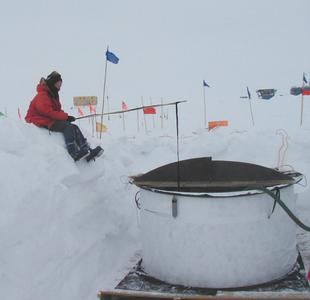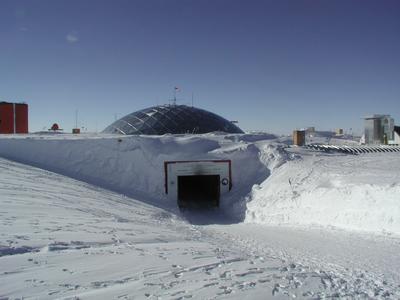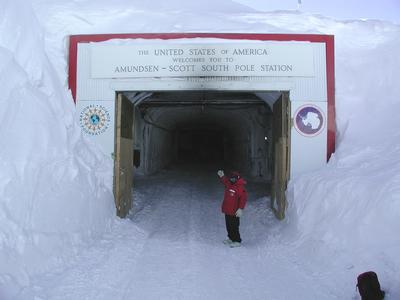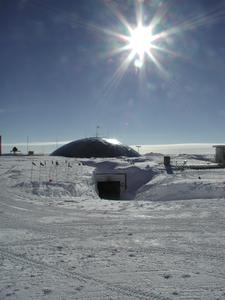19 December, 2001
Tonight I am hopefully spending my last day the South Pole. The flight from McMurdo has just left, and if it sucessfully arrives here it will be the plane that initiates the process of getting me home. If the flight is cancelled due to weather or mechanical reason, I will remain at the South Pole until well after Christmas.
The tank continues to freeze. While conducting one of the numerous temperature readings, I was visited by Dr. Katherine Rawlins. She was one of my teachers at the University of Wisconsin - River Falls. Dr. Rawlins just received her Ph.D. in physics and will be spending an entire year at the South Pole assisting with the AMANDA project. After taking a look at the ice, she sat on the edge of the snow and pretended to be fishing. A common analogy made about neutrino research is "fishing for neutrinos". This comparisons is made because neutrinos are elusive parcticles and it takes a great deal of effort and patience to study them.
AMANDA is a prototype detector, just like the detector I am working on. AMANDA is composed of an array of optical modules embedded in the ice. The focus of AMANDA is to detect neutrinos that pass through the Northern Hemisphere of the Earth and interact with water molecules in the ice. This interaction produces muons, which generate light. The light is detected by the optical modules, allowing the original path of the neutrino to be determined. The experimentation conducted with AMANDA was successful in reconstructing the path of neutrinos. Therefore, a larger array will be constructed called ICECUBED. This will be an array of optical modules buried in the ice beginning at 1000 meters below the surface. The array will be 1000 meters by 1000 meters by 1000 meters. This increase in size will allow more neutrinos to be detected and point sources determined.
AMANDA sometimes get tricked. A muon generated by an air shower over the South Pole can have its downward direction distorted by the ice. This distortion can trick AMANDA into thinking it has detected an upward muon. Hence, a method of discriminating upward versus downward muons had to be devised.
The project I have been working on at SPASE is designed to only detect downward, or air shower generated, muons. Since the concept has proven to be effective, it also will have a next phase...called ICETOP. ICETOP will consist of an array of detectors constucted over the holes where the ICECUBED strings will be deployed. The two experiments will work together. ICECUBED, buried beneath the ice, will detect upward traveling muons. ICETOP, lying atop the ice, will detect downward traveling muons. If a muon is detected in both experiments, their original direction of travel can be determined by which experiment detected the muon first. If ICETOP detects the muon first, then it had to be generated in an air shower, thus traveling downward. In this case, ICECUBED would ignore that data and ICETOP would keep it. However, if ICECUBED detects the muon first, then the muon had to be generated by a neutrino traveling upward from the Northern Hemisphere. In this case, ICECU!
BED would keep that data and ICETOP would disregard it.
The two experiments working together will allow greater resolution of nuetrinos and muons generated by air showers. Currently we do not know what source is capable of generating the energies of the parcticules that ICETOP and ICECUBED are designed to study. However, when the experiments are complete, scientists such as Dr. Rawlins maybe able to discover the answer. Doing so will help us unlock some of the deepest mysteries of the universe. However, no scientist works alone on such a task. Science involves team work and open communications. This research will take over a decade to complete. This means that if you, the reader of this journal, are in school, you could be in a few years working at the South Pole on this very project that I described.
The public address system just announced that the flight from McMurdo is 30 minutes from landing. I must pack up and prepare for my potential flight back to McMurdo. With clear skies and my patience eroded, I hope that my departure from the South Pole will soon be a reality.
Biological Data
Saturated Oxygen: 90%
Pulse Rate: 95
Weather Data
Temperature: -13.3 F
Wind Chill: -50.0 F

Dr. Katherine Rawlins "fishing" in our detector.

The famous dome at the Amundsen-Scott South Pole Station.

The entrance to the dome buried under snow.

The final photograph taken from the South Pole.
Contact the TEA in the field at
.
If you cannot connect through your browser, copy the
TEA's e-mail address in the "To:" line of
your favorite e-mail package.
|
